A Comprehensive Guide to Weeping Trees
For a more lush landscape, consider branching out a bit by planting a weeping tree.
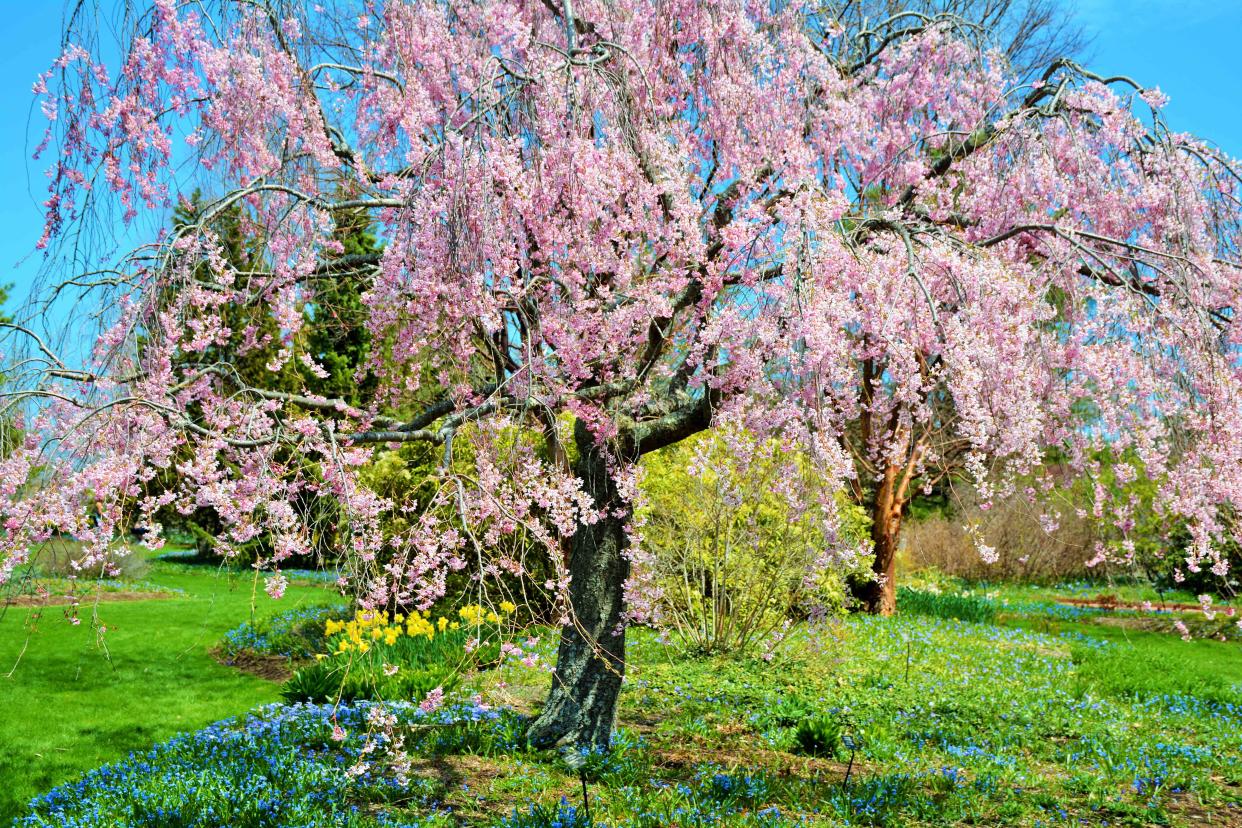
Bonnie Donovan/Getty Images
Weeping trees make a striking statement with their long, downward branches that cascade toward the ground. There are various types of weeping trees, but they all share the common characteristic of branches that droop downward, creating an elegant, cascading effect. If you want a stunning ornamental plant for your yard or garden, a weeping tree is the perfect choice.
Weeping trees offer more than good looks and elegance, however. They can provide shade and help control erosion and excess moisture in the ground. Picking the right weeping tree for your landscape can give you years of beauty and lasting rewards. Experts share the most common weeping trees you can consider for your property, plus tips for planting and caring for one.
Meet Our Expert
Samuel Davis, horticulturist and CEO of London Gardeners
Don Eaton, founder and CEO of Bower & Branch
Types of Weeping Trees
Weepiness is a natural growth habit in some trees, but many weeping trees available for planting are cultivars, which are cultivated varieties of existing tree species selected explicitly for their cascading branches. The downward-growing branches give weeping trees a graceful, unique look. Some weeping trees have flowers and leaves, while others have needles and cones. Below are the most popular types of weeping trees.
Camperdown Elm
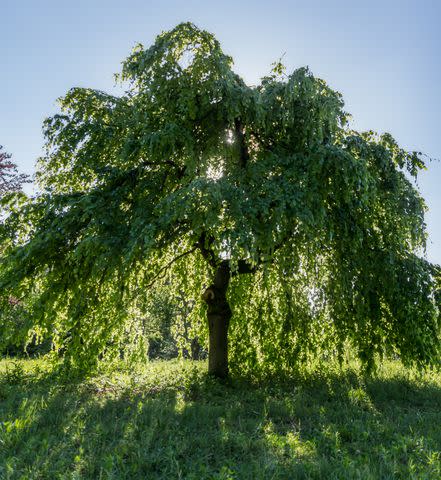
Wirestock/Getty Images
The Camperdown Elm (Ulmus glabra Camperdownii) originated in Dundee, Scotland. The elegant weeping trees have dense green foliage and twisted branches. Also called weeping elm, Scotch elm, or umbrella elm, this weeping tree is relatively small but broad, growing up to 25 feet tall and 20 to 30 feet wide.
The sprawling, deciduous tree has dark green leaves that turn yellow in the fall. Leaves are typically about 8 inches long, broad, and double-toothed. Camperdown Elms prefer full to partial sun and do best with minimal pruning. It thrives in hardiness zones 4 through 6.
Related: Here's a Full Guide to the USDA Gardening Zones
Golden Curls Willow
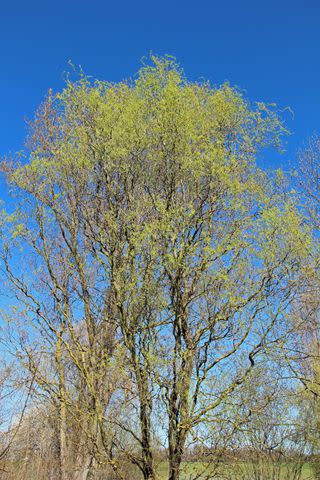
fotolinchen/getty images
The Golden Curls Willow (Salix matsudana) is an adaptable tree with twisted branches and leaves. The Golden Curls Willow is known by many names, including dragon’s claw, curly willow, Hankow willow, rattlesnake willow, contorted willow, Pekin willow, globe willow, and twisted twig willow.
The tree offers a striking focal piece year-round, with branches that transform from bright golden yellow in the winter and early spring to bronze-gold in the summer. Leaves are lance-shaped and twisted. The leaves are green in spring and summer and turn gold in the autumn before falling off. The golden tree grows up to 40 feet tall and 20 feet wide. It does well in hardiness zone 4.
Inversa Norway Spruce
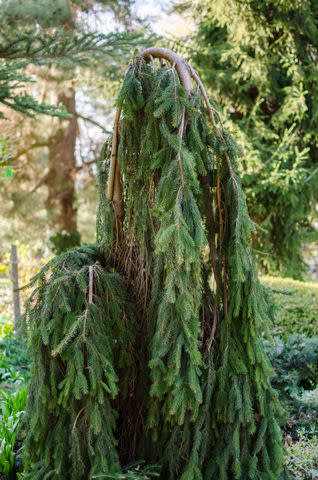
Annetka/Getty Images
The Inversa Norway Spruce (Picea abies Inversa) has glossy green needles and cascading branches that grow downward. The hardy weeping tree can be grown upright with a stake or wall for support or can naturally grow as ground cover.
Depending on how it's grown, the Inversa Norway Spruce can range from 2 to 30 feet tall and 1 to 20 feet wide. The cold-tolerant tree thrives in cool temperatures and grows well in hardiness zones 2B through 7A.
Nootka Cypress
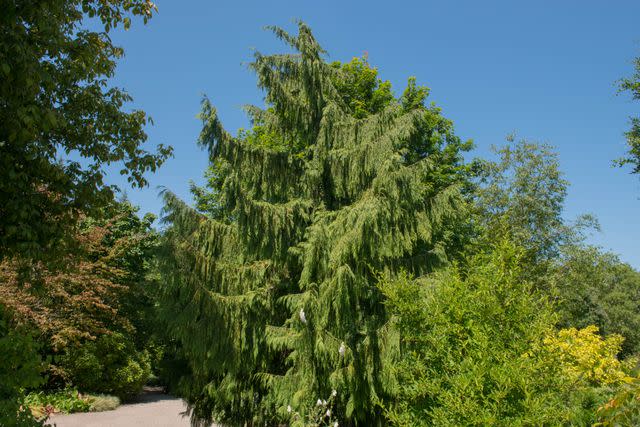
pcturner71/getty images
The Nootka Cypress (Xanthocyparis nootkatensis) is an elegant evergreen weeping tree with a pyramidal shape. Nootka Cypress trees are also known as Sitka cypress, yellow cypress, Alaska cedar, Nootka cedar, and yellow cedar.
Its dark gray-green foliage cascades down from upcurved branches for a majestic look. The low-maintenance conifer tree ranges from 2 to 35 feet tall and 8 to 12 feet wide. It thrives in hardiness zones 4 through 7.
Weeping Birch
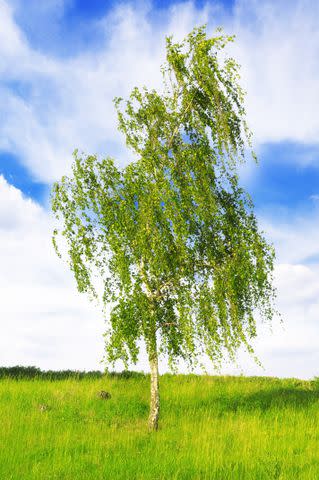
Serg_Velusceac/Getty Images
The Weeping Birch tree (Betula pendula) has stunning white or light-colored bark and graceful cascading branches, making it an excellent ornamental tree.
The Weeping Birch has branches that droop downward and leaves that transform from green to golden in the fall. The trees can grow up to 100 feet tall, and most varieties prefer cooler climates, like hardiness zones 2 through 7.
Some popular types of weeping birch trees include Young’s weeping birch, Carelica, Dalecarlica, Golden Cloud, Gracilis, Laciniata, Purpurea, and Tristis.
Higan Cherry
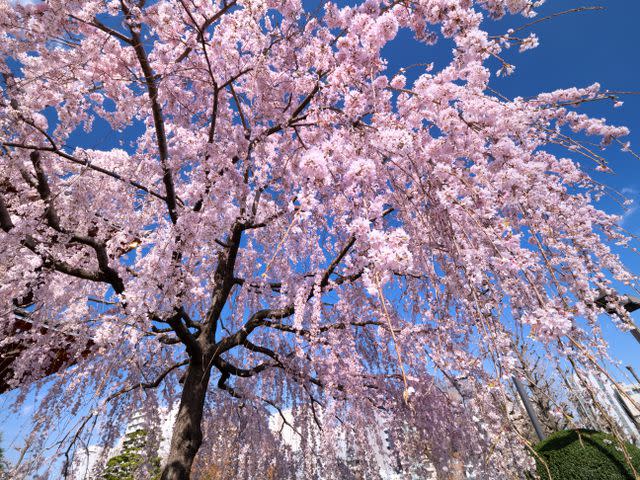
y-studio/Getty images
The Higan Cherry tree (Prunus subhirtella) is a showstopper in the spring, with brilliant pink and white cherry blossoms and cascading branches. Also known as the spring cherry or rosebud cherry, the weeping tree includes single or double five-petal flowers that bloom in early spring.
Higan Cherry trees grow 20 to 30 feet tall and 15 to 25 feet wide and thrive in temperate climates in hardiness zones 6 through 8.
Related: These Fast Growing Trees Will Afford You More Privacy at Home
Characteristics and Features of Weeping Trees
The defining feature of a weeping tree is its drooping branches. Unlike upright trees that grow straight up, weeping trees have branches that grow downwards, often reaching all the way to the ground. This creates a soft, flowing form that resembles a waterfall of greenery.
Depending on the species, weeping trees can have different shapes. Some, like the Camperdown Elm, have a cascading, umbrella-like canopy. Others, like the Higan cherry, have a more pendulous form with cascading branches weeping from a central trunk. The leaves of weeping trees also vary depending on the species. Some have shapes like teardrops (weeping birch) or needles (Nootka Cypress and Inversa Norway Spruce).
Most weeping trees grow well in temperate to cool climates and offer striking gold-tinged colors in fall and stunning, bare silhouettes in winter. The ideal growth conditions for a weeping tree depend on the exact type, but most flourish with well-draining soil and full to partial sunlight.
Related: 20 Easy Landscaping Ideas to Add Instant Curb Appeal to Your Home
How to Choose and Plant Weeping Trees
Consider your space, growing conditions, and aesthetic preferences when choosing a weeping tree for your landscape. Choose a tree that will fit in your desired space when it’s fully grown.
“The choice of a weeping tree should be guided by the tree’s mature size and aesthetic compatibility with your garden,” says Samuel Davis, horticulturist and CEO of London Gardeners. “Consider the available space, as some species require more room to flourish. Additionally, the tree’s form—a dramatic focal point or a serene backdrop—should complement your garden’s design.”
Light and Soil Requirements
Also, ensure the type of weeping tree you select suits the soil and sunlight conditions. Most weeping trees do best in well-draining soil with full to partial sunlight, but check the specific requirements for your tree variety.
“When planting, ensure the hole is twice as wide and just as deep as the root ball,” Davis says. “Incorporating organic matter into the backfill can enhance soil structure. Mulch around the base while avoiding direct contact with the trunk to help retain moisture and regulate soil temperature.”
Tips
Be mindful of the downward-growing branches, and handle your weeping tree with care when planting. “Weeping trees require special handling and care when planting—many selections are more brittle than you would expect,” says Don Eaton, founder and CEO of Bower & Branch. “With the lower weeping branching being in the work space, it will require being aware to avoid tree damage when handling.”
How to Care for Weeping Trees
Weeping trees flourish with well-draining soil and regular watering. Your tree’s exact needs depend on what type of weeping tree you have. Root rot can strike weeping trees in water-logged conditions, so refrain from overwatering and ensure the soil is well-draining.
Pruning
In general, weeping trees do not require a lot of pruning. When pruning, respect the tree’s natural form and remove only dead, diseased, or crossing branches, Davis advises. Weeping trees can be pruned to keep their form more formal or more open and natural, depending on your preference.
“Pruning weeping trees is most easily done during dormant periods, before leaves form each spring,” says Eaton. “Weeping trees tend to branch more thickly and do benefit from pruning to thin out and improve airflow within the tree, which will help the tree ward off leaf diseases.”
Common Pests and Diseases
As with other trees, weeping trees may be subject to common pests and diseases, but some preventative and natural measures can go a long way in protecting your tree.
Tips
“Monitor for signs of pests like aphids and diseases such as powdery mildew,” Davis says. “Early detection and treatment, including eco-friendly options like neem oil, can prevent more severe problems. Encouraging biodiversity in your garden can also promote natural pest control.”
Weeping trees can offer shady solace for pets, kids, and wildlife. Birds and bees love weeping trees for their safe spaces. You can monitor bees and wildlife to ensure they don’t become a nuisance in your yard.
“Bees love to build nests within the protection of weeping trees. Birds love weeping trees for the same reasons as bees—safety and protection,” Eaton says. “The thick and sometimes crossed branching makes it more difficult for predators to reach the nest. Weeping trees attract wildlife because of the endless bows of shelter.”
Related: 23 Landscape Ideas to Upgrade Your Backyard and Improve Your Mood
For more Real Simple news, make sure to sign up for our newsletter!
Read the original article on Real Simple.
